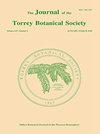Morphology, geographic distribution, and conservation status of the southern Appalachian endemic, Solidago lancifolia (Asteraceae)1,2
IF 0.8
4区 生物学
Q4 PLANT SCIENCES
引用次数: 1
Abstract
Abstract Taxonomic recognition of Solidago lancifolia (Torrey & A. Gray) Chapman and diagnostic characters used for identification have vacillated among floras and treatments. Fieldwork greatly expanded the specimen base in US herbaria, extended the known range in Tennessee, and identified new occurrences in North Carolina and Virginia. A morphometric analysis of herbarium specimens identified qualitative and quantitative characters unambiguously diagnostic for S. lancifolia. These included the presence of glands on the phyllaries; long, wide-diameter rhizomes; thick stems; and a long pappus on disk florets. Using these characters, an analysis of herbarium specimens corrected widespread misidentifications and showed that S. lancifolia is strictly endemic to a 12-county region encompassing the high elevations (> 1,400 m) in the mountains of southwestern Virginia, northwestern North Carolina, and northeastern Tennessee. Based on the narrow geographic range and small population sizes, prior uncertainty of the taxonomic validity and geographic range of S. lancifolia has been resolved. Consequently, for North Carolina and Virginia, the recommendation is for an upgrade in the conservation status to “Endangered” with a state rank of “S1.” Moreover, the narrow geographic range and small number of populations are consistent with a global rank of “G2” and consideration as a federal Species of Concern.南阿巴拉契亚特有植物紫花Solidago lancifolia (Asteraceae)的形态、地理分布及保护现状1,2
摘要一枝黄花(Solidago lancifolia, Torrey & A. Gray) Chapman)的分类识别和用于鉴定的诊断性状在不同的区系和不同的处理中摇摆不定。野外工作极大地扩展了美国植物标本馆的标本库,扩大了田纳西州的已知范围,并在北卡罗来纳州和弗吉尼亚州发现了新的出现点。对植物标本馆标本进行形态计量学分析,确定了水仙的定性和定量特征。这些包括在茎节上的腺体的存在;长,宽直径的根状茎;浓密的茎;在盘状小花上有长冠状体。利用这些特征,对植物标本馆标本的分析纠正了广泛存在的错误识别,并表明lancifolia严格局限于12个县的地区,包括弗吉尼亚州西南部、北卡罗来纳州西北部和田纳西州东北部的高海拔地区(约1400米)。由于其地理分布范围窄,种群规模小,解决了以往对其分类有效性和地理分布范围的不确定性。因此,对于北卡罗来纳州和弗吉尼亚州,建议将保护状态升级为“濒危”,州级为“S1”。此外,地理范围窄,种群数量少,符合“G2”的全球排名,并被考虑为联邦关注物种。
本文章由计算机程序翻译,如有差异,请以英文原文为准。
求助全文
约1分钟内获得全文
求助全文
来源期刊
CiteScore
0.70
自引率
0.00%
发文量
16
审稿时长
>12 weeks
期刊介绍:
The Journal of the Torrey Botanical Society (until 1997 the Bulletin of the Torrey Botanical Club), the oldest botanical journal in the Americas, has as its primary goal the dissemination of scientific knowledge about plants (including thallopyhtes and fungi). It publishes basic research in all areas of plant biology, except horticulture, with an emphasis on research done in, and about plants of, the Western Hemisphere.

 求助内容:
求助内容: 应助结果提醒方式:
应助结果提醒方式:


